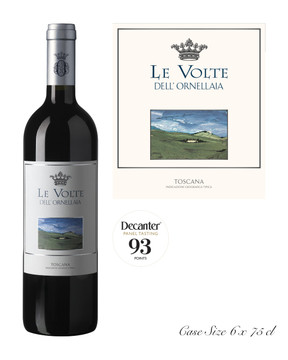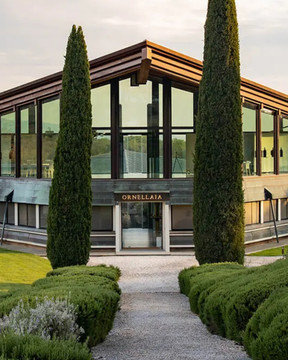

Crafted from the same varieties, under the same sky, from the same philosophy: Le Serre Nuove dell’Ornellaia is a proud second vin, which has the ability to foretell the personality of the estate’s flagship wine. Together, the two wines provide their own distinctive points of view. The pleasure of sipping Le Serre Nuove dell’Ornellaia evolves over time, adding the charm of maturity to the vigour of youth.
WINEMAKER’S TASTING NOTES
“Le Serre Nuove dell’Ornellaia 2020 unabashedly reveals generous aromas of ripe red fruit. Soft and enticing on the palate, showing phenomenal balance between body, fullness and elegance.” - Olga Fusari, Winemaker, April 2022.
THE 2020 GROWING SEASON
After a mild and rainy winter, there was a temporary drop in temperatures in March with a few nights below 0°C at the very start of the budding in the last week of the month. Fortunately, the newly opened shoots were still protected by the cottony tissue of the bud and were not damaged by the frost. The rest of spring had generally warm weather with normal rainfall that ensured regular growth until flowering, which took place on average between 20 and 25 May. There was an intense rainy period in the middle of June, followed by a very long dry period with a virtual absence of rain and torrid temperatures until the end of August. The véraison was even and quick between 20 and 25 July, with the grapes beginning to ripen under a blazing sun.
Rains arrived at the end of August, resulting in a significant drop in temperatures, falling as low as 13°C at night, and creating the ideal conditions for completing the ripening of the Merlot grapes. They were harvested in just two weeks to preserve maximum freshness and fruitiness, just in time to avoid a sudden week-long heatwave during which the thermometer registered temperatures of up to 37 degrees, sending sugar content soaring for all the varieties still to be harvested. This led us to begin harvesting Cabernet Franc and Cabernet Sauvignon from young vines as early as 17 September.
Towards the end of September, a passing burst of rain finally brought the climatic conditions back to normal, and the water absorbed by the grapes lowered the alcohol content to normal values, allowing us to complete the Cabernet Sauvignon and Petit Verdot harvest on 3 October.
VINIFICATION AND AGEING
The grapes were handpicked into 15 kg baskets. The bunches were selected by hand on a double sorting table before and after de-stemming, then finally soft-pressed. In addition to handpicking, we introduced optical selection in 2016 in order to further increase the quality of berry selection. Each variety and each parcel of land was vinified separately. The alcoholic fermentation took place partly in stainless steel tanks and partly in concrete vats at temperatures between 22-28°C for two weeks, followed by maceration for a total of about 10-15 days. The malolactic fermentation took place in stainless steelwas after which the wines were racked into barriques (25% new and 75% used once). The wine remained in barriques in Ornellaia's temperature-controlled cellars for about 15 months. After the first 12 months the wine was blended and then returned to the barriques for an additional three months of ageing. The wine remains in the bottle for another six months prior to release - Axel Heinz, Estate Director.
Crafted from the same varieties, under the same sky, from the same philosophy: Le Serre Nuove dell’Ornellaia is a proud second vin, which has the ability to foretell the personality of the estate’s flagship wine. Together, the two wines provide their own distinctive points of view. The pleasure of sipping Le Serre Nuove dell’Ornellaia evolves over time, adding the charm of maturity to the vigour of youth.
WINEMAKER’S TASTING NOTES
“Le Serre Nuove dell’Ornellaia 2020 unabashedly reveals generous aromas of ripe red fruit. Soft and enticing on the palate, showing phenomenal balance between body, fullness and elegance.” - Olga Fusari, Winemaker, April 2022.
THE 2020 GROWING SEASON
After a mild and rainy winter, there was a temporary drop in temperatures in March with a few nights below 0°C at the very start of the budding in the last week of the month. Fortunately, the newly opened shoots were still protected by the cottony tissue of the bud and were not damaged by the frost. The rest of spring had generally warm weather with normal rainfall that ensured regular growth until flowering, which took place on average between 20 and 25 May. There was an intense rainy period in the middle of June, followed by a very long dry period with a virtual absence of rain and torrid temperatures until the end of August. The véraison was even and quick between 20 and 25 July, with the grapes beginning to ripen under a blazing sun.
Rains arrived at the end of August, resulting in a significant drop in temperatures, falling as low as 13°C at night, and creating the ideal conditions for completing the ripening of the Merlot grapes. They were harvested in just two weeks to preserve maximum freshness and fruitiness, just in time to avoid a sudden week-long heatwave during which the thermometer registered temperatures of up to 37 degrees, sending sugar content soaring for all the varieties still to be harvested. This led us to begin harvesting Cabernet Franc and Cabernet Sauvignon from young vines as early as 17 September.
Towards the end of September, a passing burst of rain finally brought the climatic conditions back to normal, and the water absorbed by the grapes lowered the alcohol content to normal values, allowing us to complete the Cabernet Sauvignon and Petit Verdot harvest on 3 October.
VINIFICATION AND AGEING
The grapes were handpicked into 15 kg baskets. The bunches were selected by hand on a double sorting table before and after de-stemming, then finally soft-pressed. In addition to handpicking, we introduced optical selection in 2016 in order to further increase the quality of berry selection. Each variety and each parcel of land was vinified separately. The alcoholic fermentation took place partly in stainless steel tanks and partly in concrete vats at temperatures between 22-28°C for two weeks, followed by maceration for a total of about 10-15 days. The malolactic fermentation took place in stainless steelwas after which the wines were racked into barriques (25% new and 75% used once). The wine remained in barriques in Ornellaia's temperature-controlled cellars for about 15 months. After the first 12 months the wine was blended and then returned to the barriques for an additional three months of ageing. The wine remains in the bottle for another six months prior to release - Axel Heinz, Estate Director.
